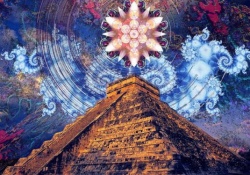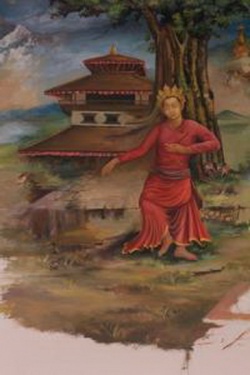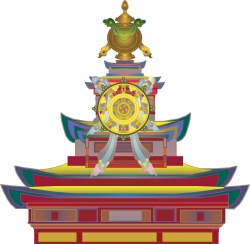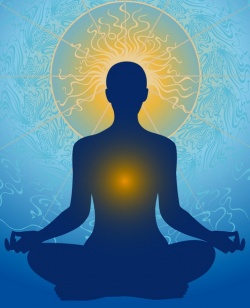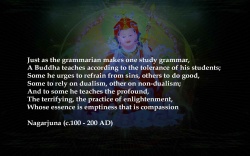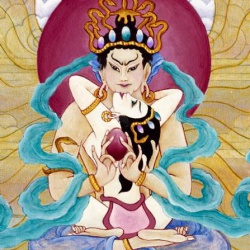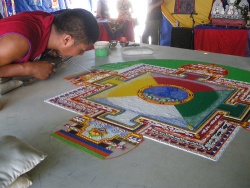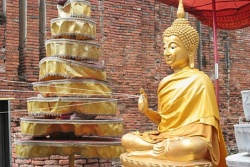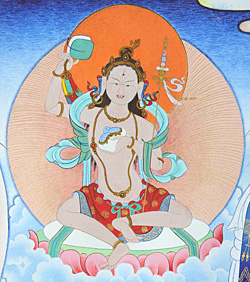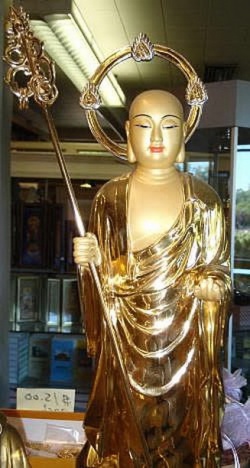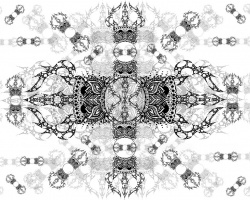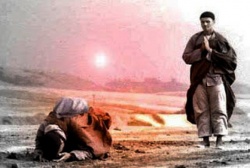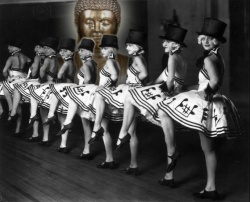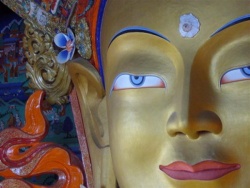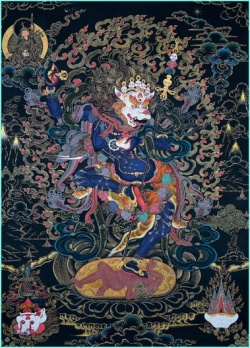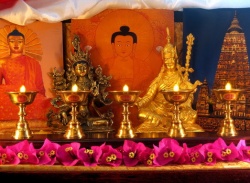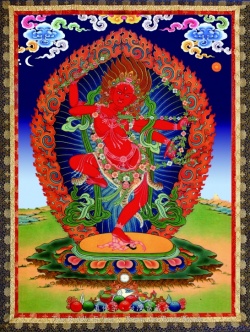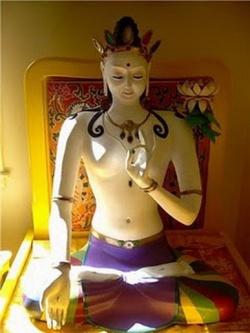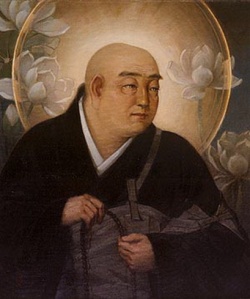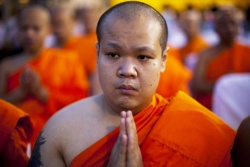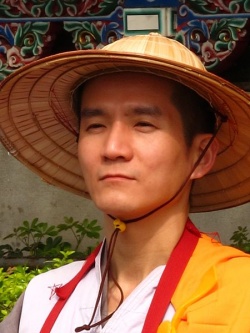Linking Buddhist Kamma with Recent Telomere Scientific Discoveries By Venerable Canberra Damita
Linking Buddhist Kamma with Recent Telomere Scientific Discoveries
By
Venerable Canberra Damita,
Young-at-Heart Meditation Research Centre, Sydney
Abstract
Australia's 11th Nobel laureate, Professor Elizabeth Blackburn was awarded the 2009 Noble Prize for microbiological discoveries and studies on telomeres and telomerase enzyme. Her current work base is at the University of San Francisco, California who I tried to get an interview and found out after several attempts that her schedule was totally booked at least for 2015.
In 2011, I was looking through the Noble Prize lists and stumbled upon her recent work on telomeres. Immediately, I saw a possible correlation with the functionality of telomeres and the characteristic nature of Buddhist kamma. I asked the question, ‘Is Kamma similar in Nature to the recent studies on Telomere Functionality?’ Since then, I have made some telomere correlations with Buddhist kamma that was on my mind. What I began to see was similarities that we, the Buddhist community in general, see in the Law of Kamma. Recent observations like Dr Therese Dale (who I had the pleasure of meeting, also very busy) and others also confirmed the findings that Professor Elizabeth Blackburn had uncovered.
I believe the discoveries on telomeres make it interesting times for Buddhists all over the World. Buddhist kamma may at last have its day of reckoning and the proof it needs to show the Science World that kamma does indeed exist with the backing of scientific discoveries.
My examination below aims to highlight, and possibly address for the first time a real scientific link to implicate that the Law of Kamma (Skt. karma) does exist at the microbiological level at the time of birth, during and at the end of life in the telomeres located at the ends of each chromosome. Hence, I wish to share those similarities with honored members present here in the 4th International Conference on Buddhism in Australia for discussion and consideration.
Introduction
So far, Buddhists familiar with Kamma, its’ Cause and Effect over the 3 periods of time know of its’ innate presence. For the Scientific World, there is little or no concrete evidence to support its’ existence. However, the recent discoveries of telomeres located at the ends of each chromosome maybe the breakthrough Buddhism needs to establish that the Law of Kamma exists at birth, throughout life and at the end of life, even a momentary gap linking the life continuum to the next existence and so on until the human being attains Nibbāna.
Background Notes On Telomeres
A Broad History of Events [1] A telomere[1] is a region of repetitive DNA at the end of a chromosome, which protects the end of the chromosome from deterioration.
In the 1970s there was no recognition that the telomere-shortening mechanism normally limits cells to a fixed number of divisions, or animal studies suggesting that this is responsible for aging on the cellular level and sets a limit on lifespans.
Russian theorist Alexei Olovnikov was the first to recognize (1971) the problem of how chromosomes could replicate right to the tip, as such was impossible with replication in a 5' to 3' direction. To solve this and to accommodate Leonard Hayflick's idea of limited somatic cell division, Olovnikov suggested that DNA sequences would be lost in every replication phase until they reached a critical level, at which point cell division would stop.
However, Olovnikov's prediction was not widely known except by a handful of researchers studying cellular aging and immortalization. It remained for a privately funded collaboration from biotechnology company Geron to isolate the genes for the RNA and protein component of human telomerase in order to establish the causal role of telomere shortening in cellular aging and telomerase reactivation in cell immortalization.
During cell division, enzymes that duplicate the chromosome and its DNA cannot continue their duplication all the way to the end of the chromosome. If cells divided without telomeres, they would lose the ends of their chromosomes, and the necessary information they contain. (In 1972, James Watson named this phenomenon the "end replication problem".) The telomeres are disposable buffers ‘protecting’ the ends of the chromosomes and are consumed during cell division and replenished by an enzyme, the telomerase reverse transcriptase. They have been likened to the aglets (tips) on the ends of shoelaces that keep them from fraying.
In 1975–1977, Blackburn, working as a postdoctoral fellow at Yale University with Joseph Gall, discovered the unusual nature of telomeres, with their simple repeated DNA sequences composing chromosome ends. Their work was published in 1978. The telomere shortening mechanism normally limits cells to a fixed number of divisions, and animal studies suggest that this is responsible for aging on the cellular level and sets a limit on lifespan.
Professor Blackburn won with her long-time US collaborators Jack Szostak, who worked on the telemores unique DNA sequence, and Carol Greider, who co-identified the telomerase. Professor Blackburn is a vocal advocate of independent scientific thought who fell out with the Bush administration over cloning and stem cells. She was dropped from George Bush's Council on Bioethics in 2004 after questioning its bias.
Elizabeth Blackburn, Carol Greider, and Jack Szostak were awarded the 2009 Nobel Prize in Physiology or Medicine for the discovery of how chromosomes are protected by telomeres and the enzyme telomerase. Professor Blackburn explains it in a 3-part video. [2]
Today, it is established that telomeres protect a cell's chromosomes from fusing with each other or rearranging—abnormalities that can lead to cancer—and so cells are destroyed when their telomeres are consumed. Most cancers are the result of "immortal" cells that have ways of evading this programmed senescence.
Evidence To-Date On Kamma
We, the Buddhist fraternity know of its’ existence. We know that no one has come back from death[2] and tell the experts living in the human plane what happened.
Other evidence implies something of a link between lives exists with individual experiences of near death experiences. Coma patients are another indicator that suggests a possible link exists, especially when a coma patient wakes up after many years apparently asleep.
Other studies regarding Hypnotic Retrospective Analysis (HRA)[3] suggest that a definite link exists, but nothing to suggest the link is kammic. Numerous observations and studies[4] [3] have shown that a person is regressed back to their childhood, to the time of their birth and far into one’s past lives linked through that person. The fact that past lives are linked to the person in the current existence tells us ‘a definite link of some kind’ exists, but what and how it is, is the unknown facts to link it to Buddhist kamma. Rather than address here all the aspects of Kamma in detail, I have only listed the major aspects of kamma in Attachment A. It is for the individual to add or investigate the details at a later time.
HRA is just a term I introduced in my book, Understanding Ourselves Better, Vol.1 Chapter 8 to describe the process of a hypnotist regressing the patient back to their childhood, and beyond one's birth and into their past lives. Those past lives are somehow conditionally linked to the hypnotized person in the present. The reason why this can be deduced is that each time the person is regressed more detailed information about that existence arises. What is recorded down during the hypnotic state, the person doesn't know anything about what is spoken. Later on the information is researched and validated (not always). If there was only one life lived to get it right why and where do these previous lives come from? If they randomly occur, it suggests the view (some skeptics believe) of spontaneous existence. However, if that were true the information obtained each time the person is regressed would be different. What actually happens is that the regressed patient provides more details of that previous existence! Why! A possible conditional link ... Edgar Cayce (1877-1945) is the most, well known for his readings and documentation done. He was an American psychic, also known as the sleeping prophet and father of holistic medicine. Although he was illiterate and uneducated, he used his psychic ability to help many people and some 30,000 transcripts of his readings were record.
In some studies, people who are regressed back past their birth in this lifetime experience no gaps from one existence to another. However, other people showed small to large gaps between one existence and another human existence. These gaps could account for other lifestyles (Animal, Heavenly, Hungry Ghost, Demigod or Demonic and Hell) in any other plane of existence that exist in Buddhist Cosmology, being 31 distinct planes of existence (see Attachment B). It should be noted that within each distinct plane of existence, there are endless types and variations to that existence just as there is in the human plane of existence.
An extrapolation of the above studies shows a definite link whatever that is, does connect that human being in the present from one existence to another. By establishing that there is a definite link means that spontaneous existence as an alternative solution has less validity. ‘Spontaneous existence’ occurs when there is no cause from the past or reason why a living being is born, and so could, for example arise as half human-half animal. However, in mythical stories this does happen [half man-half horse) - not judging here they are true or false - only to illustrate the possibility.
Differences in perception in those who believe in one or many lifetimes[5] should also be considered here. In one view, Society may want human beings to think that there is one lifetime to be lived, to get it right and then end our life maybe pushed because it is convenient to manage, especially in terms of growth, economies of scale and creating a competitive marketplace in all aspects of life. Everyone in this belief system, being economical, religious or community lifestyle competes for their share of happiness whatever that might be across all walks of life.
When a person’s belief system includes many lifetimes, that need to compete is lessened by one’s definition of what one means ‘to become content and happy’ and relates to less chronic stress during one’s life. One difference is when a person who asks two questions in life and answers them is more likely to have a true choice rather than a conditioned one. The two questions are:
Why was I born on this plane of existence, a human existence?
Being born, what am I supposed to do or what is my purpose for being born here?
For instance, a person who understands or reflects upon these questions that inner feeling will have a relative limit on what produces contentment and the resultant happiness. Having achieved what one was supposed to do would try to repay the good fortune had in that lifetime to prepare oneself for the journey beyond this lifetime. Everything is kamma and seen as just passing phenomena to be experienced and let go. There are 4 types of Rebirth and Kamma (action) illustrated over the 3 periods of times also defines Cause and Effect.
Hence, the above observations of many lifetimes imply with Buddhist kamma as its foundation shows that there is a minimum of three ‘causal’ lives for everyone such that spontaneous existence has less appeal (regarding evolution). What are they?
- 1. Previous life, whatever that was
- 2. Current life that we are all living through, and
- 3. An unknown existence after death in this lifetime.
Note: At death, any kamma remaining in the life continuum determines the next existence to experience. For an Arahant, the kamma remaining is so small it becomes inoperative (ahosi). For a fully Self-Enlightened Buddha, even the ahosi kamma is removed from His mind-continuum so that only absolute goodness remains.
New scientific methods and technological discoveries to compare or measure ether or space from one unit of space to another over time will be the proof in the pudding Buddhist kamma needs to completely link and reveal what Buddhists already know to the Scientific World. Until then we, Buddhists can patiently wait for that proof to manifest in the World.
A) MY EXAMINATIONS
No one here needs to be educated in matters of Buddhist kamma and its resultant effect on an individual's life. Please see Attachment A if wish to revise one’s knowledge on the subject of Kamma. I have enclosed recent works from Dr Therese Dale [4] and Helen Blau of Stanford Medicine [5] that gives all the latest findings needed to understand the studies on telomeres and telomerase enzyme.
From this information, I will briefly highlight a summary of telomere’s functionality uncovered so far are listed down here. The discoveries so far are as follows:
B) FUNCTIONALITY OF THE TELOMERES
Telomeres are RNA[6] strands that are attached to each end of a chromosome at birth. The relative size depends upon the individual. The functionality of the telomeres is to preserve the original chromosomes at the beginning of life as long as possible during and towards the end of life.
Over the period of a person's lifetime the telomere gradually shrinks in time and space as the person grows into a teenager, a young adult, obtains an education, gets a job, marries and has a family; matures into adulthood, ages, grows old and eventually dies.
C) FINDINGS FROM BIOLOGICAL RESEARCH STUDIES
1) The presence of telomeres at the beginning of life, shortens during one's life and eventually disappears towards the end of life suggest that shorter telomeres and fewer telomerase enzymes at the ends of chromosomes for each person approximates the lifespan of that person.
2) As the telomeres become shorter and shorter, preserving the whole chromosome provided at birth is threatened, and possibly could be construed as the onset of any dormant disease that is within the chromosome at question to manifest in that person.
3) In some studies, and in averaging the results over a sample group, overall the people in the study had shown the person’s telomere length increased in size or slowed down the degeneration of the telomeres at the ends of each chromosome. In some studies, the person’s telomere length decreased in size or speeded up the degeneration of the telomeres at the ends of each chromosome.
4) Some observations showed that, in averaging the results over the grouped sample, some information was lost. In these studies, and for some individuals, the telomere length increased in size or slowed down the degeneration of the telomere at the ends of each chromosome. The results show that indeed for some people, the telomeres did increase rather than decrease in that person, and against the normal trend.
5) Further studies again showed that when a person in the sample continued to do good thoughts, wholesome deeds and right actions or behaviors, the good actions appeared to slow down the degeneration process, or increase the telomere’s length in that person.
6) Further studies again showed that when a person in the sample continued to do bad thoughts, unwholesome deeds and wrong actions or behaviors, the bad actions appeared to speed up the degeneration process, or decrease the telomere’s length in that person. The lifespan of an individual appears to be ‘relatively’ fixed at birth. However, depending on one’s actions, speech and thoughts, it could shorten or lengthen one’s lifespan.
Note: Causality has not yet been conclusively proven, as the morality aspect has not been thoroughly tested. However, the indications are good for the future.
7) Other sample studies were on cancer cells. The studies found that the telomeres at the end of the cancerous chromosome vigorously multiplied and increased quickly. The observation then created a new study on what causes or triggers the telomeres in the cancer cells to increase in size. In that study the telomerase enzyme was discovered that turns telomeres on to increase in the cancer cells.
8) Recent studies indicate that meditation and yoga practices can assist in maintaining telomere length preventing or reducing telomere shortening. Please review this: http://www.sciencealert.com/world-first-evidence-suggests-that-meditation-alters-cancer-survivors-cells
D) EVALUATION OF FINDINGS
Recent evidence suggests that scientists may have found the genetic link with kamma for Buddhist understanding. The molecular biology research work conducted by Professor Elizabeth Blackburn [3] and her team[7] had discovered capsules at the end of chromosomes called telomeres. The research shows that the telomeres gradually shorten over the plants lifetime. Also, when the telomeres were chilled the gradual shortening of the telomeres temporarily stops but when it returns to normal temperatures, the telomeres would start again from where it left off. The discovery implies for Buddhists that an individual’s lifespan is relatively predetermined using these telomeres as a countdown indicator of an organism’s lifespan. Related research work shows how individual lives can influence his or her life by shortening or lengthening one’s predetermined telomere length and that prolonged and undue stress levels are a factor in shortening one’s telomere lifespan. Indirectly, this research discovery implies that doing more good activities for oneself and others has a better impact on one’s stress levels than doing more bad activities, which probably increases one’s stress levels.
Another interesting find of the research work was that the more defects in the telomeres increases the chance of becoming susceptible to disease attacks like cancer. Furthermore and in the normal situation, the research found that an enzyme causes the cellular telomeres to grow rather than gradually degenerate over time and space, which helps to understand why the cancer cells are so hard to eradicate at the cellular level.
The extrapolated explanation was that the function of the telomeres at the end of chromosomes is a double-edged sword – A lifespan countdown clock to predetermine when an individual’s life comes to an end, and the ability to influence the shortening or lengthening of that lifespan based upon how that individual chooses to live that life, and a taste of immortality that can kill through bringing the onset of cancerous cell production, sooner.
The discovery is a very important breakthrough to possibly link the function of telomers in molecular biology to what Buddhists refer to as ‘our kamma.’ The Buddhist texts explain an individual’s lifespan can be shortened or lengthened depending how an individual lives that life. We also know that when the fuel of kamma is exhausted that enlightened being ends the cycle of rebirth (and so death too).
If immortality were possible, who would want to live a lifetime sentence in prison or as an invalid, handicapped person? This possibility would not give a condemned individual a chance to start afresh with a new existence. An individual who is successful, healthy and wealthy wants to live longer if immortality was discovered natural. The unfortunate prisoner wants to start again afresh and has aversion (dosa vibhavataṇhā) towards his current life regardless of how he lived that life while the successful person wants to extend his life because he does not want it to end if it is at all possible is due to his attachment (nikanti bhavataṇhā) to his current life. Hence, the second and third Noble Truths explains kamma in this way.
The desire for immortality stems from the logic that everyone has one lifetime to get it right or wrong. There is no other way and is the driving force behind the quest for immortality. However, that logic doesn’t take into account the many inequalities individuals experience in the World today – food, dwellings, clothing and medicines, the four essential requisites explained in the Buddha’s Teachings. Take for instance, the plight of the Aboriginal cause in Australia. After 100 years, the Aboriginal people are still the most deprived people in Health and Education, and so career opportunities in this country. The Aboriginal ‘deaths in custody’ and poor living conditions are still the highest among all cultures living in Australia today. What Universal belief system allows some races to live in pseudo slavery conditions at the mercy of the wealthy, rich and well-to-do individuals in its’ country? If scientists have discovered the raw building blocks for our current life, it also implies including the raw building blocks for future existences too based on how an individual utilizes this lifetime on Planet Earth. Therefore, those who tend towards a one lifetime chance will incline towards the discovery of immortality theory while those whose belief system includes many lifetimes may not incline towards the discovery of immortality theory.
According to the Higher Buddhist Teachings (Abhidhamma), all the kammic propensities passes on to the next life as attributes or characteristic of that existence to be lived. In biological terms, the kammic propensities could constitute the genetic makeup of the individual. In another way, in the seventh book of the Abhidhamma on the Causal Relations of Strong Dependency Conditions (Upanissaya paccayo of Patthāna) shows that the seven kammic propensities from the past or previous life can cannot be changed relates to an individual’s genetic makeup, and that two kammic propensities can influence how one lives that new life. How an individual lives that life determines whether he will be reborn into another existence, which he or she can influence directly. This means that fate or destiny is absolute or not entirely in control of the decisions we make during our lifetime. These links suggest that the above discoveries are consistent with Buddhist principles of life here and beyond.
E) KAMMIC COMPARISONS
1) In the Dhamma there are 4 types of death: -
- a) Kamma-maraṇa (Death caused by the exhaustion of reproductive kamma),
- b) Jivita-maraṇa (Death caused by the exhaustion of life-force kamma),
- c) Both reproductive and life-force kamma ends together are normal deaths and
- d) One abnormal death, Akalika maraṇa (untimely death caused by a third person or object – being killed, suicide, car or pedestrian accident, early disease, etc.,)
2) Kammassako, kammayoni, kammabhundu kammapatisarano ... etc., in one possible answer means "Students, beings are owners of kamma, heir to kamma, born of kamma, related through kamma, and have kamma as their arbitrator. Kamma is what creates distinctions among beings in terms of coarseness & refinement." However, the 1st Noble Truths defines life as birth, old age, sickness and death; the last three are the three sign that Prince Siddhattha encountered when he ventured outside the palace walls
3) Generally, the results apply to all people regardless of their belief systems. The differences then boil down how a practitioner practices that belief system in terms of quantity or quality of one’s practice in this lifetime – what you sow is what you reap.
5) Shows that some individuals developed quality practices or principles in their life and has been indirectly awarded by lengthening their telomeres or slowing the degeneration process of telomeres at the ends of each chromosome. Probably, having less stress, anxiety, worries or tension in their chosen lifestyle.
6/7) The Kammavibhanga Suttanta clearly identifies the differences and consequences of good and bad actions. Some of them are illustrated as follows:
- a) Killing others or oneself, one reaps a shorter lifespan, while saving another one reaps a longer lifespan, extends or prolongs life (if one is born in the human state)
- b) By been ill tempered & easily upset, provoked, malicious or resentful in ones lifetime, one reaps an ugly disposition, while not being ill tempered & easily upset, etc one is born beautiful (if one is born in the human state)
- c) By harming other beings with his/her fists, with clods, with sticks, or with knives, one reaps a sickly life, while not harming another one reaps a healthy life (if one is born in the human state).
- d) By been envious (of others’ good fortune), one reaps a not influential life wherever reborn, while one who is not envious one reaps an influential life (if one is born in the human state).
- e) By not giving (of food, cloths, charity, etc), one reaps a poor, poverty life wherever reborn, while one who is giving etc., one reaps a wealthy life (if one is born in the human state).
- f) By been obstinate & arrogant, one reaps a low birth wherever reborn, while one who isn’t obstinate & arrogant, one reaps a high birth life (if one is born in the human state).
F) QUESTIONS FOR INVESTIGATING
1) If an individual is born without telomeres at the end of each chromosome, a dormant disease can manifest sooner in life, and probably an early death will occur.
Ans: Yes! What do you think according to one’s understanding of dhamma and kamma?
2) What causes the telomere to degenerate?
Ans: The telomere degenerates uniformly at both ends as one lives his/her life. The rate of degeneration depends on the remaining telomerase enzyme that puts a protective cap at the ends of a telomere. For some, telomere degeneration is quick, and creates the conditions for a disease to manifest, or as the first cause the chromosome pairs fuse together making it impossible to replicate itself and gradually spreads throughout the body.
What do you think according to one’s understanding of dhamma and kamma?
3) When the telomere degeneration process first begins to disappear does the telomere degenerates uniformly or randomly?
Ans: When the telomere disappears, the telomerase enzyme is also few in number and the chromosome end frays, degenerates and cannot fully replicate itself. Both: uniformly over the lifespan, and sometimes without the telomerase enzyme to protect the telomere, chromosome pairs fuse that leads to degeneration.
What do you think according to one’s understanding of dhamma and kamma?
4) When a diseased chromosome occurs after the telomere disappears, does the diseased chromosome affect all the others chromosomes uniformly, locally or randomly?’
Ans: When a diseased chromosome manifest after the telomere disappears, the term ‘cells are under constant chronic stress’ telomere and telomerase are absent or no longer functioning properly affects the chromosome locally and gradually cause genetic defects to arise.
What do you think according to one’s understanding of dhamma and kamma?
5) Does a diseased chromosome all have in common?
Ans: Yes! Recent studies show that three areas appear to be common – a) chronic stress, b) shortened telomere length, and c) fewer telomerase enzymes present in the shorter telomere. The three being present reduces the ability for cell replenishment and this can lead to diseases. It is already established that genetic defects leads to disease.
What do you think according to one’s understanding of dhamma and kamma?
6) Does the telomere shortening and ageing occur for everyone?
Ans: Earlier studies averaged the total of telomere lengths in people in a large population hid that information. For some individuals telomeres did not get shorter but even got longer. So, no! However, it is not yet proven to be causal.
Answer relates in future studies on telomere and the telomerase enzyme.
What do you think according to one’s understanding of dhamma and kamma?
7) Does the discovery of telomere functionality suggest the ‘ageless’ antidote for eternal longevity, the elixir for longevity?
Ans: Why some people’s telomeres increase in size against the Norm of them reducing in size, nobody really knows. However, as a possibility and in a material society – morality is first to go, especially in an economic depression, and fewer are practicing it in order to survive the period.
What do you think according to one’s understanding of dhamma and kamma?
G) THE CONCLUSION
The discovery of telomeres, and the supportive role of stem cell research has given Buddhist kamma another stepping stone to establish the concrete evidence from a scientific framework that kamma potentially exists at birth, during the course of one’s lifespan and at the end of life, and its’ momentary gap between existences.
H) THE FUTURE
What prevents one’s ability to go further than the physical realms of discoveries is that breakthroughs in technological and scientific equipment is the main limitation to examine one unit of space with another in time (akāsadhātu), the intangible and invisible ether element in science.
To identify that the brain is not the mind,
That intention or volition (cetanā) is kamma according to Adhidhamma[8]
While wholesome or unwholesome (kusalākusalam kamma) according to Suttanta.[9]
Establishing the scientific evidence in these areas will complete the puzzle that Western minds find hard to believe going forwards.
Until then, Buddhist practitioners will continue developing ways to explain kamma and teach it according to Suttanta and Abhidhamma.
To invent new scientific tools to compare immaterial matter with another is the area that will a real breakthrough is needed.
References
Further Reading on this website: 1) Telomere Function, 2) Telomere Shortening, 3) Telomere Lengthening 4) Telomere Measurement, 5) Systemic Telomere Length and Aging, and 6) Telomeres and Cancer
- 2. A complete video on Professor Elizabeth Blackburn explaining about the Roles of Telomeres & Telomerase in Animals and Humans: Part 1, https://www.youtube.com/watch?v=5PU_jZwt8KY; Part 2, https://www.youtube.com/watch?v=zqMoDdHWFBA; and Part 3, http://youtu.be/-lNR1xZS5GY
- 3. Understanding Ourselves Better, Dukkha, The First Noble Truth, Vol. 1, by Venerable Canberra Damita, Published by Daw Moe Kay Khine, Shwe Nathar village, Pale’ (3), Mingalardon, Yangon; Printed in Adhipati Printing House (07094), Mayangone, Kabar Aye, Yangon, Myanmar, 6 January, 2004
- 4. A useful guide to Dr Therese Dale’s reference is “Telomeres, Aging & Cancer Theresa Dale 2011”, https://s3.amazonaws.com/Dr-Dale-Doctors-Resources-PDF/Telomeres_Handout.pdf
- 5. Another study by Helen Blau on Stanford Medicine website provides more recent studies, http://med.stanford.edu/news/all-news/2015/01/telomere-extension-turns-back-aging-clock-in-cultured-cells.html
ATTACHMENT A: Aspects of Kamma Outlined
1. Kamma and 4NTs are interrelated, not separate topics
2. 1st NT – What is Dukkha? Dukkha is just kamma, good or bad
Seven Categories of kamma according to the Suttanta discourses:
i) Suffering upon suffering (dukkha-dukkha)
ii) Suffering that is subject to change (viparināma dukkha)
iii) Suffering arising from mental formations (sankhāra dukkha)
iv) Concealed Suffering (paticchanna dukkha)
v) Visible or revealed Suffering (apaticchanna dukkha)
vi) Suffering with the formation of body and mind (nāmarupa) is indirect
suffering (pariyāya dukkha)
vii) Direct Suffering (apariyāya dukkha or nippariyāya dukkha)
3. To illustrate – scales of justice/of good and bad existences or …
Good & bad balances out = reborn in a Human existence; or …
Good dominates over bad = reborn in a Heavenly existence; or …
Bad dominates over good = reborn in a Woeful existence.
4. Kamma in this human existence via the three doors (tidvāra)
In the mind = good, bad or neutral mental thoughts
In verbal speech = good, bad or neutral communication
In bodily actions = good, bad or neutral activities or events
5. By three dimensional space and time:
Past, present and future happenings (atita, paccuppanna, anāgata). At this moment in this action, in this lifetime, in this dimension!
6. Four Types of Kamma
7. Five Types of Kammic Causes and Effect
a) Four Causes for Rebirth:
In this existence, the cause and its effect occur – We Go Away & Come Again!
In this existence, the cause but the effect occurs in the future
In a past existence cause but the effect occurs in the present
In a past existence cause but the effect occurs in the future
b) No Cause to arise ends Rebirth, no effect
The kammic cause that neither has an effect in the past or present.
8. Four Death Conditions for Rebirth:
Three normal – kammic fuel, lifespan or both together expires
One Abnormal – inopportune situation or unfortunate accident
9. According to Buddha’s discourses (Sutta):
Analysis of Action discourse (Kammavibhaṅga Sutta)
Great Analysis of Action discourse (Mahākammavibhaṅga Sutta)
10. According to Buddha’s Higher Teachings (Abhidhamma):
Manas, the raw conscious mind, 89/121 distinct types of thoughts
Citta, the processing centre of the mind
Viññāṇa, the Mental Communication links, 3 doors, 6 sense organs, (6 objects & 6 sense organs)=12, (3*6 sense organs)=18, (6*18)=108
11. 9 Kammic Propensities (according to the Higher Teachings):
1.1 Good kamma followed by good kamma
1.2 Good kamma followed by bad kamma
1.3 Good kamma followed by supramundane kamma
2.1 Bad kamma followed by bad kamma
2.2 Bad kamma followed by good kamma
2.3 Bad kamma followed by supramundane kamma
3.1 Supramundane kamma followed by supramundane kamma
3.2 Supramundane kamma followed by good kamma
3.3 Supramundane kamma followed by bad kamma
Note: Kammic Propensities 1.2 and 2.2 sometimes occur in this lifetime show that fate or destiny is not absolute. The rest are past life Kammic Propensities that determine one’s existence in this lifetime. Kammic Propensities 1.1 and 1.3 imply growth; 2.1 and 2.3 imply decline; 3.1 implies the being enters while 3.2 and 3.3 determines the quality of entry into the supramundane path.
12. How to overcome our Kamma?
Through Samatha and Vipassāna meditation, observing noble silence, attaining the ten perfections, attaining the four Paths to Nibbāna, Theoretical and Practical parts, etc.,
13. Evidence that kamma exists
a) Hypnotic Regression Analysis (HRA)
b) Studies and Readings by Edgar Cayce (1877-1945)
c) Scientific related discoveries: use of Newton’s laws, Albert Einstein on Relativity,
Prof. Elizabeth Blackburn Noble Prize 2009 on telomeres
14. Recent and related articles and questions on Kamma
15. Intention (cetanā) is kamma.
ATTACHMENT B: Thirty-one Planes of Existence (or Tilokā)
The 31 distinct Planes of Existence are listed as follows, call 9 Heavenly Abodes of beings (Nava Sattāvāsā) includes the Gods (Devatā) of the Sensual world (kāmaloka), the four Heavenly Abodes of the Fine Material world (rūpaloka) and four Immaterial worlds (arūpaloka) correspond to the eight absorptions (atthajhānas) are listed in descending order as:
Subtle (Aeon) Immaterial plane of Heavenly existence (Arūpa Devā Loka)
8th 84,000 Neither perception nor non-perception (Neva saññā-nasaññāyatanūpaga Devā)
7th 60,000 Sphere of Nothingness (Ākiñcaññāyatanūpaga Devā)
6th 40,000 Sphere of Unbounded Consciousness (Viññāṇañcāyatanūpaga Devā)
5th 20,000 Sphere of Unbounded Space (Ākāsānañcāyatanūpaga Devā)
Five Non-Returner Pure Abodes (Suddhāvāsa) (invisible without a living Buddha)
16,000 Within half of a lifetime beings Antarā-parinibbāyi Anāgāmin (Akaṅitthā)
8,000 Between a half and full lifetime beings Upahacca Anāgāmin (Sudaasī)
4,000 Without exertion, or ease beings Sasaṅkhāra Anāgāmin (Sudassā)
2,000 With exertion or striving beings Asaṅkhāra Anāgāmin (Atappā)
1,000 Within five lifetimes Suddhāvāsa Anāgāmin (Avihā)
Gross Mahākappa - Fine Material plane of existence (Rūpa Loka)
4th 500 Unconscious Beings with no perception (superior) Vehapphala (Bhumi) Devā
500 (medium) Asaññā-satta (Bhumi) Devā Asankheyya
3rd 64 All Illuminating boundless beauty gods Subha-kiṇhakā Devā (superior)
32 (medium) Appamāṇā-subhā Devā
16 (weak) Paritta-subhā Devā
2nd 8 Radiant gods (superior) Ābbassarā Devā
4 (medium) Appamāṇābhā Devā
2 (weak) Parittābhā Devā
1st 1 Brahmakāyikā gods (superior) Mahābrahmā Devā
Half (medium) Brahma-purohitā Devā
Third (weak) Brahma-pārisajjā Devā
Mundane Sensual plane of existence (Kāmaloka or Saṃsāra)
(In celestial yrs) World of Gods - Devāta lokā
11. 16,000 Control over creations - Para-nimmita-vasavattino
10. 8,000 Power to Create - Nimmāṇa-rati
9. 4,000 Heaven of Pleasure - Tusitā (Abode of a Bodhisatta)
8. 2,000 Hell God - Yāmā
7. 1,000 Gods of Thirty-three - Tāvatiṃsa
6. 500 Four Great Kings - Catum-Mahā-rājikā
In (human years) World of Humankind - Manussānaṃ lokā
5. 100 Human Realm - Manussā
4. Animal Realm - Tiracchāna-yoni - (Four Woeful States – Apāya)
3. Demigods, Spirit, Demons - Asura
2. Hungry Ghosts, Goblins, Titans - Petti-visaya
1. (aeon) Hell Realm - Niraya
ATTACHMENT C: Telomeres, Aging & Cancer Theresa Dale 2011
https://s3.amazonaws.com/Dr-Dale-Doctors-Resources-PDF/Telomeres_Handout.pdf
Footnotes
- ↑ Alternative definition: A telomere is a region of repetitive nucleotide sequences at each end of a chromatid, which protects the end of the chromosome from deterioration or from fusion with neighbouring chromosomes. Its name is derived from the Greek nouns telos (τέλος) 'end' and merοs (μέρος, root: μερ-) 'part.' For vertebrates, the sequence of nucleotides in telomeres is TTAGGG. Most prokaryotes, lacking this linear arrangement, do not have telomeres. Telomeres compensate for incomplete semi-conservative DNA replication at chromosomal ends. A protein complex known as shelterin serves as protection against double-strand break (DSB) repair by homologous recombination (HR) and non-homologous end joining (NHEJ).
- ↑ Clinical death occurs when the last breath taken is the medical definition. When the mind leaves the body on the last wave of the heat element (tejodhātu) is the Buddhists definition. A corollary to that is it is only the death of the physical body (kāya), which includes the physical brain, 5 organs, skeleton and flesh to gradually breakdown and return to their original stable states - earth (solids), water (liquids), air or wind (gases) elements - Pathavi, Apo and Vayo-dhātu. The difference between the 2 types of definitions can be half-an-hour to an hour of elapsed time.
- ↑ See UOB, Vol. 1, Chapter 8: Dispelling False Views, p.156
- ↑ See UOB, Vol. 1, Chapter 8: Dispelling False Views, p.155 work of Edgar Cayce
- ↑ See UOB, Vol. 1, Chapter 8: Dispelling False Views, p.151
- ↑ Ribonucleic acid (RNA) is a polymeric molecule. It is implicated in a varied sort of biological roles in coding, decoding, regulation, and expression of genes.
- ↑ Due to Professor Elizabeth Blackburn and her team’s research discoveries, they were awarded the 2009 Noble Prize.
- ↑ In Abhidhamma, the 7th book, Patthana defines kamma (action) to be intention (cetana)
- ↑ In Suttanta kamma refers to good and bad actions, wholesome or unwholesome thoughts, meritorious or demeritorious deeds.
Source
Buddhism And Australia Conference 2015 http://buddhismandaustralia.com/
